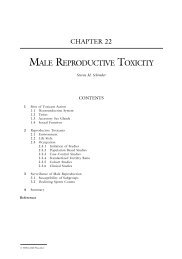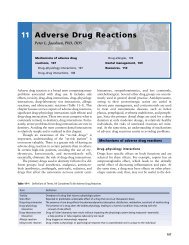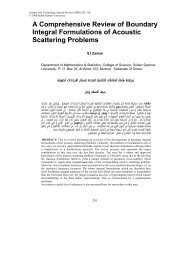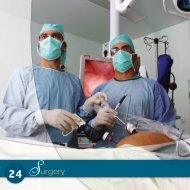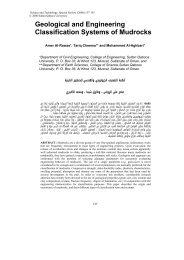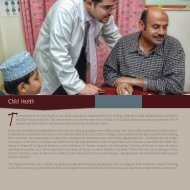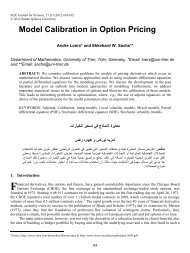<strong>Neonatal</strong> <strong>Hypotonia</strong> / 53335% of all newborns with severe hypotonia of neuromuscularorigin. This autosomal recessive disorder is thought toresult from apoptosis of the anterior horn cell. Affectedinfants have generalized weakness, absent deep tendonreflexes, tongue fasciculations, normal sensory function, andnormal CSF examination. The serum CK is usually normalor may be slightly elevated. The diagnosis is confirmed bydeoxyribonucleic acid (DNA) testing in peripheral blood forthe survival motor neuron gene on chromosome 5q (deletionof exons 7 and 8). Muscle biopsy and EMG are often notrequired in the initial evaluation unless the diagnosis cannotbe confirmed by clinical assessment and genetic testing.Electrical studies demonstrate decreased nerve conductionvelocities, low amplitude of the compound muscleaction potential, and spontaneous fibrillations. Musclebiopsy demonstrates severe denervation, with groupedatrophy and hypertrophy of type 1 fibers.Peripheral Nerve DisordersPeripheral neuropathies rarely present during the newbornperiod. Affected infants have generalized hypotoniaand diminished tendon reflexes and may have abnormalsensory examination and elevated CSF protein. The clinicalcourse is variable and may be static or evenreversible. Diagnosis can be confirmed by electrical studiesthat demonstrate slowing of nerve conduction velocities,low compound motor action potentials (CMAPs),and low sensory nerve action potentials (SNAPs). In selectcircumstances, definitive diagnosis may be made by moleculargenetic testing and rarely, sural nerve biopsy.Disorders of theNeuromuscular JunctionAffected infants have hypotonia, cranial nerve dysfunction(ptosis, bulbar dysfunction, and weak cry), areflexia,and normal sensory function.Transient neonatal myasthenia gravis occurs in approximately12% of newborns of mothers with myastheniagravis. It is not related to the severity or duration of thematernal illness or to maternal antibody levels. Affectedinfants usually have hypotonia, ptosis, feeding difficulties,and, possibly, respiratory difficulties, which resolve graduallyover several weeks or months. Diagnosis may be confirmedby a test dose of edrophonium or neostigminemethylsulfate administered intramuscularly or subcutaneously.With the latter medication, a response is expectedwithin 15 to 30 minutes. There is a major advantage of theuse of neostigmine over edrophonium in that the beneficialeffect lasts 1 to 3 hours, which permits repeated and moreprolonged evaluations to establish improvement. Ongoingtreatment with pyridostigmine and supportive care maybe required. Forms of congenital myasthenia gravis thatinvolve abnormal structure of motor end plates are rarelyseen. Response to edrophonium or neostigmine is variableand electrical studies show a decremental response to repetitivenerve stimulation at 20 Hz.Impaired presynaptic release of acetylcholine by toxins(eg, hypermagnesemia following maternal treatment ofeclampsia with magnesium sulfate and treatment withaminoglycoside antibiotics) may result in rapidly progressiveflaccid weakness, bulbar dysfunction, apnea, and autonomicabnormalities (eg, pupillary dilation and urinaryretention). In many instances, the rapid deterioration maybe misdiagnosed as sepsis, which may result in the use ofadditional antibiotic therapy and further aggravation ofthe weakness.Infantile botulism results from presynaptic neuromuscularblockade by a toxin released by the organismClostridium botulinum, which may be present in the gastrointestinaltract of young infants. This organism oftenoriginates from soil, agricultural products, and honey, andthere is wide variation in the incidence of cases, with almostone-half of all cases originating in California, Utah, andPennsylvania, where there are high levels of botulinumspores in soil. The disorder has been described in infantswho are exclusively breastfed. In addition to hypotonia,weakness, and feeding difficulties, affected infants (whowere previously healthy) have impaired pupillary responsesand constipation. Respiratory failure may occur. Diagnosisis confirmed by positive stool culture, or isolation of toxinfrom stool, or by an incremental response on rapid repetitivenerve stimulation (20 to 50 Hz) and abundant smallmotor unit potentials on EMG. Supportive managementwith possible respiratory support is required until the timeof recovery, which may be several months later. There is noproven benefit from antibiotics or antitoxin.Muscular DystrophiesThese genetically determined myopathies are characterizedclinically by progressive weakness. The histology onmuscle biopsy is nonspecific, demonstrating features ofmuscle necrosis, regeneration, and fibrosis. The investigationof these disorders is evolving rapidly with the discoveryof new gene mutations and associated abnormalities inprotein products.Congenital myotonic dystrophy is inherited exclusivelyfrom the mother. Affected newborns generally present witha combination of hypotonia, weakness, respiratory impairment,facial diplegia, feeding difficulties, and arthrogryposis.Occasionally, there may be facial weakness alone,which may remain undetected during the newbornperiod. A history of polyhydramnios or prematurity mayindicate more severe intrauterine onset of disease. There isCurrent Management in Child Neurology, Third Edition© 2005 Bernard L. Maria, All Rights Reserved <strong>Neonatal</strong> <strong>Hypotonia</strong>BC Decker Inc Pages 528–534
534 / The Hospitalized Childa high mortality rate (almost 50%), and survival may bepredicted on the basis of normal suck and swallowingfunction by 12 weeks of age. Significant cerebral dysfunctionis a frequent feature, including neuroimaging abnormalities(eg, dilated cerebral ventricles, cerebral dysgenesis,and periventricular leukomalacia). The serum CK andEMG are often normal. Diagnosis may be confirmed in themother of the affected newborn by an increase in trinucleotiderepeats (CTG) on chromosome 19q13.3.Congenital muscular dystrophies are inherited in an autosomalrecessive fashion and present with weakness, whichmay be static or which may progress. Progressive weaknessand reduced survival often occur in variants with prominentCNS features (eg, cerebral dysgenesis [Fukuyama’ssyndrome], decreased white matter and ocular abnormalities[muscle-eye-brain-disease], and Walker-Warburg syndrome).CNS features include seizures, spasticity, glaucoma,cataracts, or optic nerve abnormalities. Investigations mayreveal normal or moderate elevation of CK, myopathicchanges on EMG, possible neuroimaging abnormalities, anddystrophic changes on muscle biopsy. In cases with CNSinvolvement, immunocytochemical investigations of musclebiopsy tissue may demonstrate deficiency of merosin, aspecific protein in the muscle membrane.Congenital Myopathies withDistinct HistologyMany myopathies are classified according to their distincthistologic appearance observed on muscle biopsy. Usually,they present with hypotonia and relatively mild but staticweakness and, possibly, facial weakness. Exceptions arenemaline myopathy and X-linked myotubular myopathywhich have a severe neonatal variety with respiratory failure.Metabolic MyopathiesRarely, mitochondrial cytopathies (eg, cytochrome-c oxidasedeficiency, carnitine deficiency, carnitine palmityltransferasedeficiency, and glycogen and lipid disorders)may present during the neonatal period. Diagnosisdepends on enzyme assays and muscle biopsy results.Suggested ReadingsDubowitz V. Muscle disorders in childhood. 2nd ed. Philadelphia(PA): W.B. Saunders; 1995.Royden-Jones H, Devivo D, Darras BT. Neuromuscular diseasesof infancy, childhood and adolescence: a clinician’s approach.Philadelphia (PA): Butterworth-Heinemann; 2003.Volpe JJ. Neurology of the newborn. 4th ed. Philadelphia (PA):W.B. Saunders; 2001.Practitioner and Patient ResourcesMuscular Dystrophy Canada (MDC)2345 Young Street, Suite 900Toronto, Ontario M4P 2E5Phone: (416) 488-0030 or 800-567-2873Fax: (416) 488-7523http://www.mdac.caProvides information on neuromuscular diseases and MDC servicesand research, as well as a fund-raising newsletter.Muscular Dystrophy Association(MDA)3300 E. Sunrise DriveTucson, AZ 85718-3208Phone: 800-572-1717Fax: (520) 529-5300E-mail: mda@mdausa.orghttp://www.mdausa.orgProvides information on neuromuscular diseases, MDA services,publications, and the annual telethon.Families of Spinal Muscular AtrophyP.O. Box 196Libertyville, IL 60048-0196Phone: 800-886-1762E-mail: sma@fsma.orghttp://www.fsma.orgProvides information on spinal muscular atrophy, research, andfund-raising resources.Current Management in Child Neurology, Third Edition© 2005 Bernard L. Maria, All Rights Reserved <strong>Neonatal</strong> <strong>Hypotonia</strong>BC Decker Inc Pages 528–534





